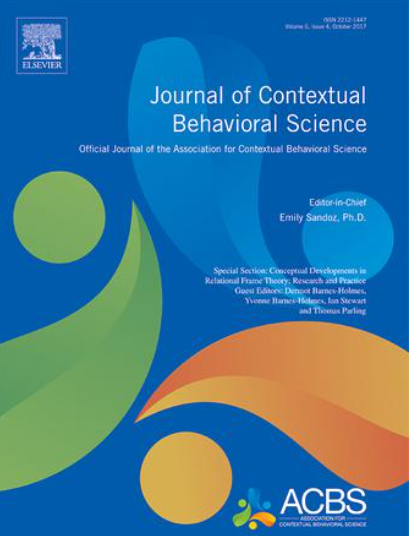The core extrusion schema, psychological inflexibility and social anxiety symptoms in Adolescents: A network analysis
IF 3
3区 心理学
Q1 PSYCHOLOGY, CLINICAL
引用次数: 0
Abstract
The core extrusion schema (CES) and psychological inflexibility (PI) significantly influence individuals’ experiences of social anxiety. Previous research has predominantly centered on correlations and regressions between PI, CES, and social anxiety, leaving a gap in understanding at the symptom level. However, investigating these symptom-level relationships may not only provide valuable insights into the dynamics among PI, CES, and social anxiety symptoms, but also point toward more targeted strategies for clinical treatment and prevention.
In this study, network analysis was employed to examine symptom-level interconnections among symptoms of PI, CES, and social anxiety in a sample of 1745 high school students. Results from the PI network highlighted the significant impact of cognitive fusion on school life, particularly how “Thoughts Hinder Performance in School” drives social anxiety symptoms. Results from both the CES network and a combined network incorporating all variables pointed to “Hiding Oneself in Socialization” and “Fear of the Real Self Being Perceived” as crucial in sustaining the co-occurrence of social anxiety symptoms, CES variables, and PI variables.
These findings may help illuminate the cognitive processes that perpetuate social anxiety symptoms and reveal precise targets for clinical intervention.
核心挤压图式、心理不灵活性与青少年社交焦虑症状:一个网络分析
核心挤压图式(CES)和心理不灵活性(PI)显著影响个体的社交焦虑体验。以往的研究主要集中在PI、CES和社交焦虑之间的相关性和回归上,在症状层面的理解上存在空白。然而,研究这些症状水平的关系不仅可以为PI、CES和社交焦虑症状之间的动态关系提供有价值的见解,而且还可以为临床治疗和预防提供更有针对性的策略。本研究以1745名高中生为研究对象,采用网络分析的方法,探讨PI、CES、社交焦虑症状之间的相互关系。PI网络的结果强调了认知融合对学校生活的重大影响,特别是“思想阻碍学校表现”如何引发社交焦虑症状。来自CES网络和包含所有变量的联合网络的结果指出,“在社会化中隐藏自己”和“对真实自我被感知的恐惧”是维持社交焦虑症状、CES变量和PI变量共同出现的关键。这些发现可能有助于阐明使社交焦虑症状持续存在的认知过程,并揭示临床干预的精确目标。
本文章由计算机程序翻译,如有差异,请以英文原文为准。
求助全文
约1分钟内获得全文
求助全文
来源期刊

Journal of Contextual Behavioral Science
PSYCHOLOGY, CLINICAL-
CiteScore
8.50
自引率
18.00%
发文量
82
审稿时长
61 days
期刊介绍:
The Journal of Contextual Behavioral Science is the official journal of the Association for Contextual Behavioral Science (ACBS).
Contextual Behavioral Science is a systematic and pragmatic approach to the understanding of behavior, the solution of human problems, and the promotion of human growth and development. Contextual Behavioral Science uses functional principles and theories to analyze and modify action embedded in its historical and situational context. The goal is to predict and influence behavior, with precision, scope, and depth, across all behavioral domains and all levels of analysis, so as to help create a behavioral science that is more adequate to the challenge of the human condition.
 求助内容:
求助内容: 应助结果提醒方式:
应助结果提醒方式:


